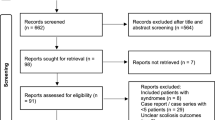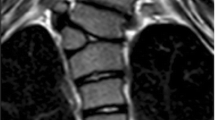Abstract
Background
Cardiac anomalies are prevalent in patients with bony spinal anomalies. Prior studies evaluating incidences of bony congenital anomalies of the spine are limited. The Kids’ Inpatient Database (KID) yields national discharge estimates of rare pediatric conditions like congenital disorders. This study utilized cluster analysis to study patterns of concurrent vertebral anomalies, anal atresia, cardiac malformations, trachea-esophageal fistula, renal dysplasia, and limb anomalies (VACTERL anomalies) co-occurring in patients with spinal congenital anomalies.
Methods
Retrospective review of KID 2003–2012. KID-supplied hospital- and year-adjusted weights allowed for incidence assessment of bony spinal anomalies and cardiac, gastrointestinal, urinary anomalies of VACTERL. K-means clustering assessed relationships between most frequent anomalies within bony spinal anomaly discharges; k set to n − 1(n = first incidence of significant drop/little gain in sum of square errors within clusters).
Results
There were 12,039,432 KID patients 0–20 years. Incidence per 100,000 discharges: 2.5 congenital fusion of spine, 10.4 hemivertebra, 7.0 missing vertebra. The most common anomalies co-occurring with bony vertebral malformations were atrial septal defect (ASD 12.3%), large intestinal atresia (LIA 11.8%), and patent ductus arteriosus (PDA 10.4%). Top congenital cardiac anomalies in vertebral anomaly patients were ASD, PDA, and ventricular septal defect (VSD); all three anomalies co-occur at 6.6% rate in this vertebral anomaly population. Cluster analysis revealed that of bony anomaly discharges, 55.9% of those with PDA had ASD, 34.2% with VSD had PDA, 22.9% with LIA had ASD, 37.2% with ureter obstruction had LIA, and 35.5% with renal dysplasia had LIA.
Conclusions
In vertebral anomaly patients, the most common co-occurring congenital anomalies were cardiac, renal, and gastrointestinal. Top congenital cardiac anomalies in vertebral anomaly patients were ASD, PDA, and VSD. VACTERL patients with vertebral anomalies commonly presented alongside cardiac and renal anomalies.


Similar content being viewed by others
Abbreviations
- ASD:
-
Adult spine deformity
- HCUP:
-
Healthcare Cost and Utilization Project
- ICD-9-CM:
-
International Classification of Disease, Ninth Revision, Clinical Modification
- IRB:
-
Institutional review board
- KID:
-
Kids’ Inpatient Database
- PDA:
-
Patent ductus arteriosus
- VACTERL:
-
Vertebral anomalies, anal atresia, cardiac malformations, trachea-esophageal fistula, renal dysplasia, and limb anomalies
References
Arlet V, Odent T, Aebi M (2003) Congenital scoliosis. Eur Spine J. https://doi.org/10.1007/s00586-003-0555-6
Bartels E, Jenetzky E, Solomon BD et al (2012) Inheritance of the VATER/VACTERL association. Pediatr Surg Int 28(7):681–685
Basu PS, Elsebaie H, Noordeen MHH (2002) Congenital spinal deformity: a comprehensive assessment at presentation. Spine (Phila Pa 1976) 27(20):2255–2259
Basude S, McDermott L, Newell S, Wreyford B, Denbow M, Hutchinson J, Abdel-Fattah S (2015) Fetal hemivertebra: associations and perinatal outcome. Ultrasound Obstet Gynecol 45(4):434–438
Beals RK, Robbins JR, Rolfe B (1993) Anomalies associated with vertebral malformations. Spine (Phila Pa 1976) 18(10):1329–1332
Bjørsum-Meyer T, Herlin M, Qvist N, Petersen MB (2016) Vertebral defect, anal atresia, cardiac defect, tracheoesophageal fistula/esophageal atresia, renal defect, and limb defect association with Mayer-Rokitansky-Küster-Hauser syndrome in co-occurrence: two case reports and a review of the literature. J Med Case Rep. https://doi.org/10.1186/s13256-016-1127-9
Botto LD, Khoury MJ, Mastroiacovo P et al (1997) The spectrum of congenital anomalies of the VATER association: an international study. Am J Med Genet 71(1):8–15
Brand MC (2008) Examination of the newborn with congenital scoliosis: focus on the physical. Adv Neonatal Care 8(5):265
Cunningham BK, Hadley DW, Hannoush H, Meltzer AC, Niforatos N, Pineda-Alvarez D, Sachdev V, Warren-Mora N, Solomon BD (2013) Analysis of cardiac anomalies in VACTERL association. Birth Defects Res Part A Clin Mol Teratol 97(12):792–797
Cunningham BK, Khromykh A, Martinez AF, Carney T, Hadley DW, Solomon BD (2014) Analysis of renal anomalies in VACTERL association. Birth Defects Res Part A - Clin Mol Teratol 100(10):801–805
Debnath UK, Goel V, Harshavardhana N, Webb JK (2010) Congenital scoliosis—Quo vadis? Indian J Orthop. https://doi.org/10.4103/0019-5413.61997
Dice JE, Bhatia J (2007) Patent ductus arteriosus: an overview. J Pediatr Pharmacol Ther JPPT 12(3):138–146
Giampietro PF, Raggio CL, Blank RD, McCarty C, Broeckel U, Pickart MA (2013) Clinical, genetic and environmental factors associated with congenital vertebral malformations. Mol Syndromol 4(1–2):94–105
Goldstein I, Makhoul IR, Weissman A, Drugan A (2005) Hemivertebra: prenatal diagnosis, incidence and characteristics. Fetal Diagn Ther 20(2):121–126
Jayaswal A, Kandwal P, Goswami A, Vijayaraghavan G, Jariyal A, Upendra BN, Gupta A (2016) Early onset scoliosis with intraspinal anomalies: management with growing rod. Eur Spine J. https://doi.org/10.1007/s00586-016-4566-5
Jog S, Patole S, Whitehall J (2002) Congenital scoliosis in a neonate: can a neonatologist ignore it? Postgrad Med J 78(922):469 LP–469472
de Jong EM, Felix JF, Deurloo JA, van Dooren MF, Aronson DC, Torfs CP, Heij HA, Tibboel D (2008) Non-VACTERL-type anomalies are frequent in patients with esophageal atresia/tracheo-esophageal fistula and full or partial VACTERL association. Birth Defects Res A Clin Mol Teratol 82(2):92–97
Al Kaissi A, Kalchhauser G, Klaushofer K, Handlbauer A, Grill F (2012) Distinctive vertebral abnormalities in a patient with VACTERL association. RöFo - Fortschritte auf dem Gebiet der Röntgenstrahlen und der Bildgeb Verfahren 184(1):62–65
Khoury MJ, Cordero JF, Greenberg F, James LM, Erickson JD (1983) A population study of the VACTERL association: evidence for its etiologic heterogeneity. Pediatrics 71(5):815–820
Koç T, Lam KS, Webb JK (2013) Are intraspinal anomalies in early onset idiopathic scoliosis as common as once thought? A two centre United Kingdom study. Eur Spine J 22(6):1250–1254
MacEwen GD, Winter RB, Hardy JH (1972) Evaluation of kidney anomalies in congenital scoliosis. J Bone Joint Surg Am 54(7):1451–1454
Muirhead A, Conner AN (1985) The assessment of lung function in children with scoliosis. J Bone Joint Surg Br 67(5):699–702
Nora AH, Nora JJ (1975) A syndrome of multiple congenital anomalies associated with teratogenic exposure. Arch Environ Health 30(1):17–21
Oestreich AE, Young LW, Young Poussaint T (1998) Scoliosis circa 2000: radiologic imaging perspective. I Diagnosis and pretreatment evaluation Skeletal Radiol 27(11):591–605
Poorman GW, Jalai CM, Diebo BG et al (2017) Congenital etiology is an independent risk factor for complications in adolescents undergoing corrective scoliosis surgery: comparison of in-hospital comorbidities using Nationwide KID’s Inpatient Database. J Pediatr Orthop. https://doi.org/10.1097/BPO.0000000000000990
R Core Team, Team RC (2012) R: a language and environment for statistical computing. R Found Stat Comput Vienna, Austria URL http//wwwR-projectorg/ 21 October 2017
Rajasekaran S, Kamath V, Kiran R, Shetty AP (2010) Intraspinal anomalies in scoliosis: an MRI analysis of 177 consecutive scoliosis patients. Indian J Orthop 44(1):57–63
Reller MD, Strickland MJ, Riehle-Colarusso T, Mahle WT, Correa A (2008) Prevalence of congenital heart defects in metropolitan Atlanta, 1998–2005. J Pediatr 153(6):807–813
Reutter H, Hilger AC, Hildebrandt F, Ludwig M (2016) Underlying genetic factors of the VATER/VACTERL association with special emphasis on the “Renal” phenotype. Pediatr Nephrol 31(11):2025–2033
Shen J, Wang Z, Liu J, Xue X, Qiu G (2013) Abnormalities associated with congenital scoliosis. Spine (Phila Pa 1976) 38(10):814–818
Solomon BD (2011) VACTERL/VATER association. Orphanet J Rare Dis 6(1):56
Solomon BD, Pineda-Alvarez DE, Raam MS, Bous SM, Keaton AA, Velez JI, Cummings DAT (2010) Analysis of component findings in 79 patients diagnosed with VACTERL association. Am J Med Genet A 152A(9):2236–2244
Solomon BD, Pineda-Alvarez DE, Raam MS, Cummings DAT (2010) Evidence for inheritance in patients with VACTERL association. Hum Genet 127(6):731–733
Solomon BD, Raam MS, Pineda-Alvarez DE (2011) Analysis of genitourinary anomalies in patients with VACTERL (vertebral anomalies, anal atresia, cardiac malformations, tracheo-esophageal fistula, renal anomalies, limb abnormalities) association. Congenit Anom (Kyoto) 51(2):87–91
Temtamy SA, Miller JD (1974) Extending the scope of the VATER association: definition of the VATER syndrome. J Pediatr 85(3):345–349
Author information
Authors and Affiliations
Corresponding author
Ethics declarations
Conflict of interest
Dr. Passias reports personal fees from Medicrea, personal fees from SpineWave, non-financial support from Allosource, personal fees from Zimmer Biomet, personal fees from Globus, grants from CSRS, personal fees from Aesculap, outside the submitted work. All other authors certify that they have no affiliations with or involvement in any organization or entity with any financial interest (such as honoraria; educational grants; participation in speakers’ bureaus; membership, employment, consultancies, stock ownership, or other equity interest; and expert testimony or patent-licensing arrangements) or non-financial interest (such as personal or professional relationships, affiliations, knowledge, or beliefs) in the subject matter or materials discussed in this manuscript.
Ethical review committee statement
All procedures performed in studies involving human participants were in accordance with the ethical standards of the institutional and/or national research committee Institutional Review Board and with the 1964 Helsinki declaration and its later amendments or comparable ethical standards. For this type of study, formal consent is not required.
Additional information
This article is part of the Topical Collection on Spine - Other
Rights and permissions
About this article
Cite this article
Passias, P.G., Poorman, G.W., Vasquez-Montes, D. et al. Cluster analysis describes constellations of cardiac anomalies presenting in spinal anomaly patients. Acta Neurochir 160, 1613–1619 (2018). https://doi.org/10.1007/s00701-018-3596-7
Received:
Accepted:
Published:
Issue Date:
DOI: https://doi.org/10.1007/s00701-018-3596-7




